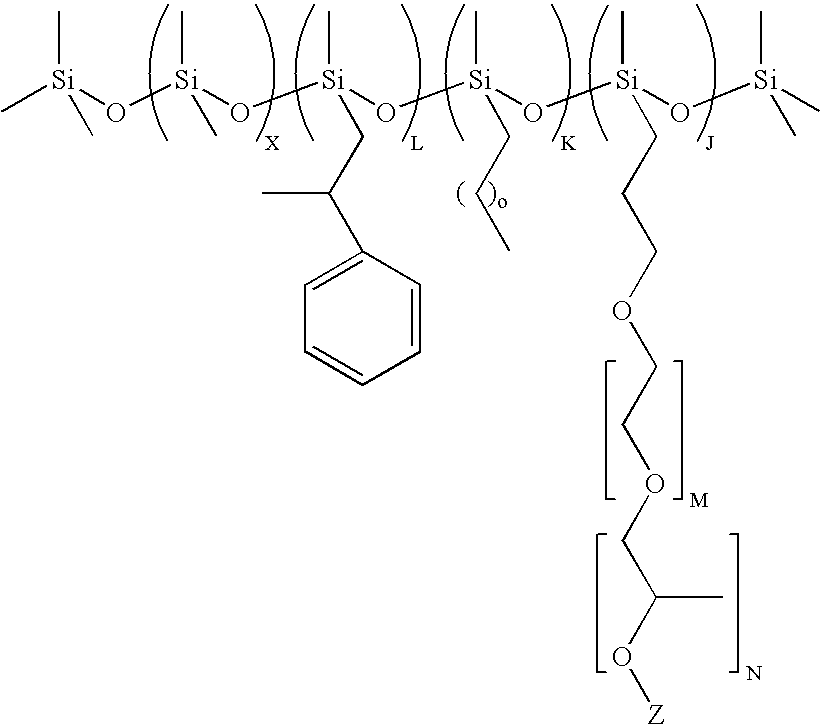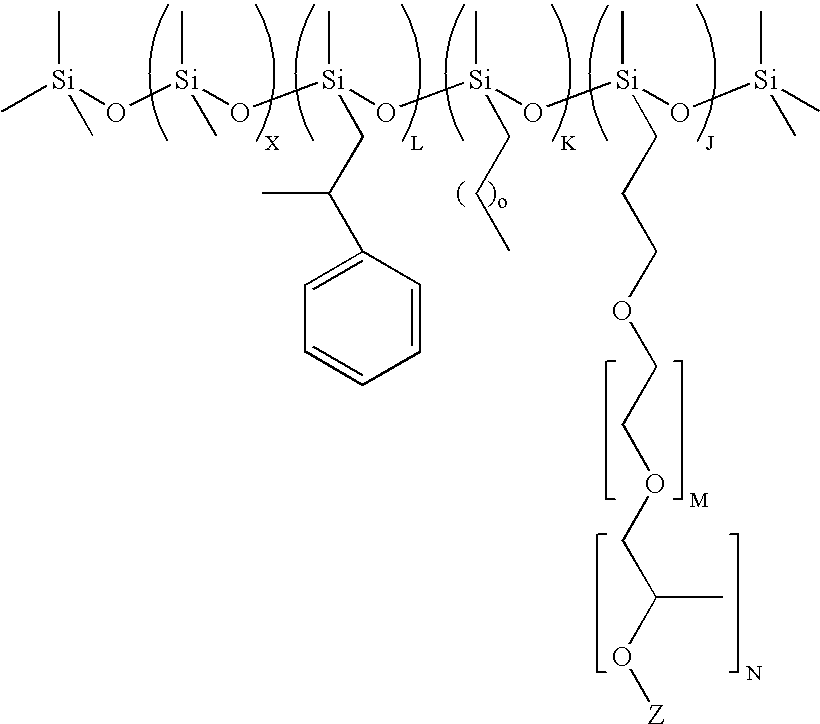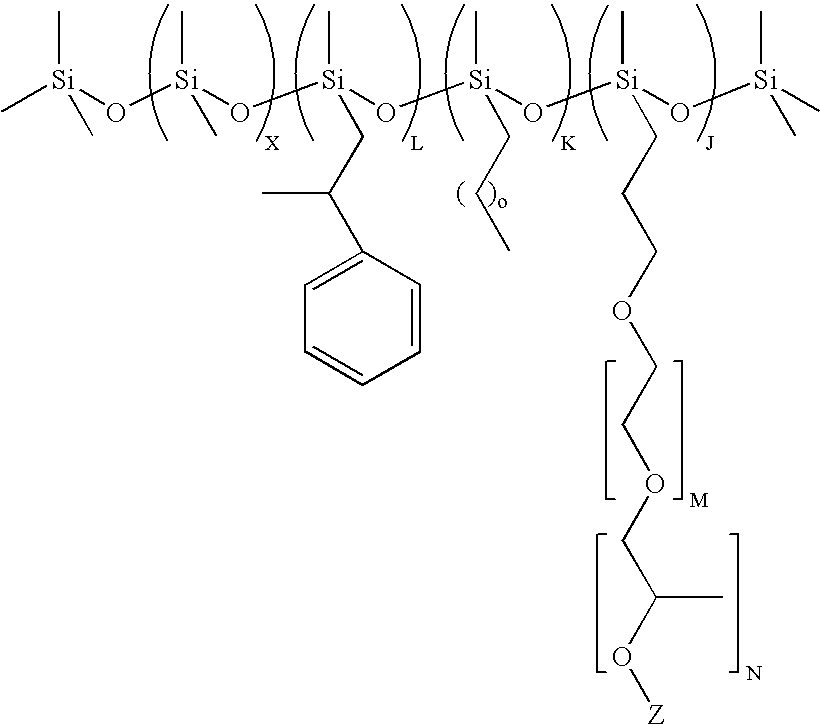Polyorganosiloxane demulsifier compositions and methods of making the same
a technology of polyorganosiloxane and demulsifier, which is applied in the direction of dewatering/demulsification with chemical means, other chemical processes, chemical separation processes, etc., can solve the problems of insufficient separation of mechanical separation, inability to provide adequate separation, and inability to meet the requirements of oil emulsion, etc., to achieve cost-effective and practical effects, improve the separation of components in stabilized emulsion
- Summary
- Abstract
- Description
- Claims
- Application Information
AI Technical Summary
Benefits of technology
Problems solved by technology
Method used
Image
Examples
example 1
Preparation of (CH3)3Si(OSi(CH3)2)75(OSi(H)(CH3))36OSi(CH3)3
[0092]Polymethylhydrogen-co-dimethylsiloxane fluid with average formula (CH3)3Si(OSi(CH3)2)75(OSi(H)(CH3))36OSi(CH3)3 was prepared by acid catalyzed ring opening polymerization of polymethylhydrogensiloxane with the average formula (CH3)3Si(OSi(H)(CH3))36OSi(CH3)3 and octamethylcyclotetrasiloxane (D4, from Momentive Performance Materials, Wilton, Conn.) in the presence of Tulison TP63, an acidic ion exchange resin (IER, from Thermax Ltd, India). The reaction was carried out by mixing 216 g of (CH3)3Si(OSi(H)(CH3))36OSi(CH3)3, 555 g D4 and 7.5 g of IER at 60° C. for 24 hrs in a round bottom flask fitted with a condenser. At the end of the reaction the IER was filtered out and the final non-volatile fraction in the resulting copolymer was found to be 92%. The average structure was determined by 29Si-NMR.
example 2
Preparation of (CH3)3Si(OSi(CH3)2)75(OSi(H)(CH3))13.3OSi(CH3)3
[0093]Polymethylhydrogen-co-dimethylsiloxane fluid with average formula (CH3)3Si(OSi(CH3)2)75(OSi(H)(CH3))13.3OSi(CH3)3 was prepared by acid catalyzed ring opening polymerization of hexamethyldisiloxane (MM, from Sigma Aldrich, USA) polymethylhydrogensiloxane with the average formula (CH3)3Si(OSi(H)(CH3))36OSi(CH3)3 (from Momentive Performance Materials, Wilton, Conn.) and D4, in the presence of Tulison TP63 IER. The reaction was carried out by mixing 10.2 g of MM, 216 g of (CH3)3Si(OSi(H)(CH3))36OSi(CH3)3, 555 g D4 and 7.5 g of IER, at 50° C. for 24 hrs in a round bottom flask fitted with a condenser. At the end of the reaction the IER was filtered out and the final non-volatile fraction in the resulting copolymer was found to be 90%. The average structure was determined by 29Si-NMR
example 3
Preparation of (CH3)3Si(OSi(CH3)2)2(OSi(C6H5)2)2(OSi(H)(CH3))13.3OSi(CH3)3
[0094]Polymethylhydrogen-co-dimethyl-codiphenylsiloxane terpolymer with average formula (CH3)3Si(OSi(CH3)2)2(OSi(C6H5)2)2(OSi(H)(CH3))13.3OSi(CH3)3 was prepared by acid catalyzed ring opening polymerization Polydimethyl-co-diphenylsiloxane with the average formula (CH3)3Si(OSi(CH3)2)2(OSi(C6H5)2)2OSi(CH3)3 (from Momentive Performance Materials, Wilton, Conn.) and tetramethylcyclo-tetrasiloxane (DH4, from Gelest, Tullytown, Pa.), in the presence of Tulison TP63 IER. The reaction was carried out by mixing 46.6 g of polydimethyl-co-diphenylsiloxane, 80 g DH4 and 1.5 g of IER at 80° C. for 24 hrs in a round bottom flask fitted with a condenser. At the end of the reaction the IER was filtered out and the final non-volatile fraction in the resulting copolymer was found to be 90%. The average structure was determined by 29Si-NMR
PUM
| Property | Measurement | Unit |
|---|---|---|
| temperatures | aaaaa | aaaaa |
| droplet sizes | aaaaa | aaaaa |
| droplet sizes | aaaaa | aaaaa |
Abstract
Description
Claims
Application Information
 Login to View More
Login to View More - R&D
- Intellectual Property
- Life Sciences
- Materials
- Tech Scout
- Unparalleled Data Quality
- Higher Quality Content
- 60% Fewer Hallucinations
Browse by: Latest US Patents, China's latest patents, Technical Efficacy Thesaurus, Application Domain, Technology Topic, Popular Technical Reports.
© 2025 PatSnap. All rights reserved.Legal|Privacy policy|Modern Slavery Act Transparency Statement|Sitemap|About US| Contact US: help@patsnap.com



